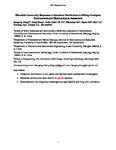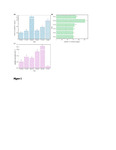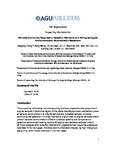Microbial Community Responses to Vanadium Distributions in Mining Geological Environments and Bioremediation Assessment
| dc.contributor.author | Zhang, Baogang | |
| dc.contributor.author | Wang, S | |
| dc.contributor.author | Diao, M | |
| dc.contributor.author | Fu, Jie | |
| dc.contributor.author | Xie, M | |
| dc.contributor.author | Shi, J | |
| dc.contributor.author | Liu, Z | |
| dc.contributor.author | Jiang, Y | |
| dc.contributor.author | Cao, X | |
| dc.contributor.author | Borthwick, Alistair | |
| dc.date.accessioned | 2021-08-22T15:49:30Z | |
| dc.date.available | 2021-08-22T15:49:30Z | |
| dc.date.issued | 2019-03 | |
| dc.identifier.issn | 2169-8953 | |
| dc.identifier.issn | 2169-8961 | |
| dc.identifier.uri | http://hdl.handle.net/10026.1/17686 | |
| dc.description.abstract |
<jats:title>Abstract</jats:title><jats:p>Vanadium mining activities can cause contamination of the surrounding geological environment. Vanadium may exist in multiple matrices due to its migration and transformation, forming interactive relationships; however, the connection between vanadium distributions in multiple matrices and microbial community responses remains largely unknown. Vanadium is a redox‐sensitive metal that can be microbiologically reduced and immobilized. To date, bioremediation of vanadium‐contaminated environments by indigenous microorganisms has rarely been evaluated. This paper reports a systematic investigation into vanadium distributions and microbial communities in soils, water, and sediment from Panzhihua, China. Large vanadium contents of 1130.1 ± 9.8 mg/kg and 0.13 ± 0.02 mg/L were found in surface soil and groundwater. Vanadium in surface water tended to precipitate. Microbial communities isolated from similar environments were alike due to similarity in matrix chemistry whereas communities were distinct when compared to different matrices, with lower richness and diversity in groundwater. <jats:italic>Proteobacteria</jats:italic> was distributed widely and dominated microbial communities within groundwater. Redundancy analysis shows that vanadium and nutrients significantly affected metal‐tolerant bacteria. Long‐term cultivation (240 days) suggests the possibility of vanadium bioremediation by indigenous microorganisms, within acid‐soluble fraction. This active fraction can potentially release mobile vanadium with shifted redox conditions. Vanadium (V) was bio‐reduced to less toxic, mobile vanadium (IV) primarily by enriched <jats:italic>Bacillus</jats:italic> and <jats:italic>Thauera</jats:italic>. This study reveals the biogeochemical fate of vanadium in regional geological environments and suggests a bioremediation pathway via native vanadium‐reducing microbes.</jats:p> | |
| dc.format.extent | 601-615 | |
| dc.language | en | |
| dc.language.iso | en | |
| dc.publisher | American Geophysical Union (AGU) | |
| dc.title | Microbial Community Responses to Vanadium Distributions in Mining Geological Environments and Bioremediation Assessment | |
| dc.type | journal-article | |
| dc.type | Journal Article | |
| plymouth.issue | 3 | |
| plymouth.volume | 124 | |
| plymouth.publication-status | Published | |
| plymouth.journal | Journal of Geophysical Research: Biogeosciences | |
| dc.identifier.doi | 10.1029/2018jg004670 | |
| plymouth.organisational-group | /Plymouth | |
| plymouth.organisational-group | /Plymouth/Faculty of Science and Engineering | |
| plymouth.organisational-group | /Plymouth/Faculty of Science and Engineering/School of Engineering, Computing and Mathematics | |
| plymouth.organisational-group | /Plymouth/Users by role | |
| plymouth.organisational-group | /Plymouth/Users by role/Academics | |
| dc.identifier.eissn | 2169-8961 | |
| dc.rights.embargoperiod | Not known | |
| rioxxterms.versionofrecord | 10.1029/2018jg004670 | |
| rioxxterms.licenseref.uri | http://www.rioxx.net/licenses/all-rights-reserved | |
| rioxxterms.type | Journal Article/Review |




